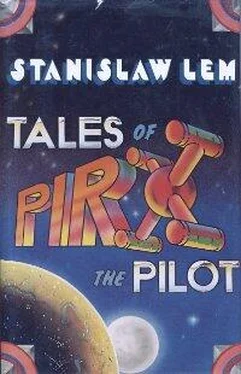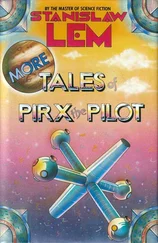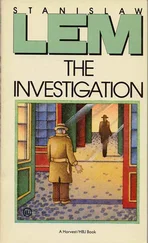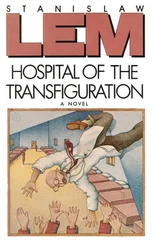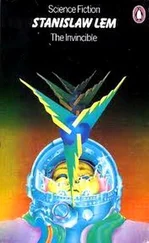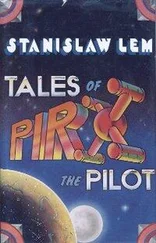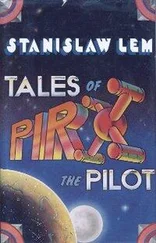He settled on the smaller one. The pilot and Langner held their peace. The pilot, leading the way, then opened the air lock; when all were inside, he unscrewed the manhole cover and pushed open the outer hatch.
If not for Langner, Pirx would have hopped right out onto the scree, which, in view of the twenty-meter drop, would have meant a sprained ankle or worse. Despite the lesser gravity, the weight of his space suit would have made the impact equivalent to jumping down into a pile of extremely loose rock from one story up.
The pilot lowered a collapsible ladder, and one by one they egressed onto the Moon.
There were no welcoming parties, no one with flowers, no trumpet blasts. In fact, there was not a living soul in sight. About a kilometer away, its armor-plated dome grazed by oblique rays of awesome lunar sunlight, the Tsiolkovsky station rose prominently above the plain. A little higher up, hewn in the rock, was a small landing pad, now occupied by a double row of rockets—transports, judging by their size.
Their ship, listing slightly to one side, hunkered down on its triadic, steel-footed assembly, blackening with exhaust the rocks directly beneath its thrust chambers. The terrain to the east was relatively flat, if an endless boulder-cluttered plain—some stones were the size of apartment houses—could be called flat. Rearing gently eastward, it fringed off into a wall of vertical faults to become the central massif of the Tsiolkovsky mountain. A blazing Sun, poised ten degrees above the ridge, blinded them every time they turned their gaze in its direction. Pirx, like the others, lowered his sun visor, but it failed to cut down the glare altogether, at most enabling him to look without squinting. Cautiously picking their way in and out of the shifting boulders, they shoved off for the station, eventually losing sight of the shuttle when they had to cross the flat-bottomed basin. The station commanded a view of the basin and the surrounding landscape, three-fourths of the structure being recessed in a wall of highland mass strangely evocative of a stone fortress from the Mesozoic era. Its lopped-off cornices bore a striking similarity to ancient turrets, but only from a distance; the closer one got to them, the more these “turrets” abandoned their symmetrical shape, the more clearly one saw their deep cracks, too easily mistaken for black stripes from far off. The terrain was fairly navigable by lunar standards. Each bootstep raised a cloud of dust—the celebrated lunar dust—that would climb waist-high, gird them in immaculate white, and refuse to settle, forcing them to walk three abreast. When they reached the station, Pirx cast a backward glance and saw three tubular, serpentine trails, brighter than any dust or powder he had ever known on Earth.
On the subject of lunar dust Pirx was somewhat knowledgeable. He recalled how amazed the first explorers had been by its behavior. Although they had anticipated it, according to all laws known to them even the finest-particle dust should have settled in an airless vacuum; not lunar dust—but oddly enough, only during the daytime, under conditions of sunlight. Later it was discovered that electrical phenomena behave differently on the Moon. Lightning, thunder, St. Elmo’s fire, and other atmospheric discharges common to Earth are unknown on the Moon. Lunar rocks, because they are subjected to a constant bombardment of particle radiation, have the same charge as the dust mantling them. And since electrical charges of the same polarity are mutually repellent, the dust, if disturbed, remained in suspension, frequently for hours, thanks to this electrostatic repulsion. The more sunspots there were, the “dustier” the Moon. But the dust cloud phenomenon ceased at night—a night so biting cold that a man’s only protection was his specially designed double-ply Thermoslike space suit, which even in the Moon’s thinner atmosphere weighed like holy hell. These scientific musings were soon interrupted by their arrival at the station’s main entrance. They were given a warm welcome. The station’s scientific supervisor, Professor Ganshin, was an exceptionally tall man—tall even by Pirx’s standards, whose own height had always been seen as a compensation for his chubbiness. But Ganshin looked down on him—not figuratively, but literally. His colleague, Dr. Pnin, a physicist, turned out to be even taller—a towering two meters.
There were four other Russians present, not counting those who may have been on duty. The station’s upper level housed an astronomical observatory and a radio station. A sloping concrete passage, tunneled through solid rock, led up to a small radome—huge gyrating dishes of the grid type. Through the side ports the eye made out, at the station’s edge, a shimmering, perfectly symmetrical spiderweb: the radio-telescope, the most powerful on the Moon.
The station was deceptive, being much larger than it looked. There were, besides the station proper, several underground storage tanks containing water, air, and food; and transformers for converting solar energy into electricity, housed in a wing sequestered deep inside a rocky crevasse, so that it was not visible from below. And something else, the most sumptuous thing of all: a gigantic hydroponic solarium under a dome of steel-reinforced quartz, in the center of which, surrounded by myriad flowers and large vats of algae, the main source of vitamins and protein, there stood, of all things, a banana tree. Pirx and Langner were treated to their first Moon-grown banana. With a congenial smile, Dr. Pnin explained that bananas were excluded from the crew’s daily menu, being reserved strictly for guests.
Langner, no amateur when it came to lunar engineering, began probing his host for details concerning the quartz dome’s construction, whose ingenious conception had aroused his admiration even more than the bananas. And it was, without doubt, ingenious. Because of its exposure to vacuum conditions, the dome had to withstand a constant pressure of nine tons per square meter, which, taking into account its surface area, yielded an impressive 2,800 tons. Under such atmospheric pressure, the confined air mass could easily burst the quartz bubble to smithereens. Having to dispense with ferroconcrete, the engineers had reinforced the quartz with welded ribs, transferring the main pressure load, roughly three million kilograms’ worth, onto the indium plate at the apex. Powerful branching steel cables were strung outside, radially, where they were anchored deep within the surrounding basalt crust, transforming the dome into a bizarre “tethered quartz balloon.”
It being lunchtime at the Tsiolkovsky station, they went directly from the solarium to the dining room. It was Pirx’s third meal of the day—the first was aboard the Selene, the second at Luna Base. From the looks of things, that’s all people did on the Moon: eat lunch. The dining room, which also functioned as a lounge, was rather cozy in size, paneled—not wainscoted—in natural pine, still redolent of resin. This uncanny touch of “worldliness,” after exposure to the blinding lunar landscape, was a welcome relief. But Professor Ganshin informed them that the wood paneling was only veneer, installed to ease the crew’s homesickness.
Neither during nor after lunch was any mention made of anything even remotely connected with the Mendeleev station. Not a word about the accident, the fate of the two Canadians, or even about their upcoming departure. The prevailing mood was that of a leisurely social visit.
The Russians fairly doted on them. Eager for news—any kind of news—they continuously plied their guests with questions. What news from Earth? From Luna Base? In a rush of sincerity, Pirx owned to having a basic dislike for tourists; by the responses, he had a sympathetic audience. Time passed. The Russians later took turns slipping in and out. They soon discovered why: a solar prominence had been sighted from the observatory—and was it ever a beaut! At the mere mention of the words “solar prominence,” Langner became a man totally obsessed. The whole table, in fact, was seized by that sort of self-obliterating passion common to the profession. Upstairs they examined the lab photos, then the film recorded by the coronograph, both of which revealed the prominence to be one of exceptional magnitude—750,000 kilometers in length. To Pirx it had the look and shape of some antediluvian monster with flaming jaws. But no one besides Pirx was at all interested in zoological comparisons. As soon as the lights came back on, Ganshin, Pnin, Langner, and a third astronomer launched into a heated discussion, with eyes aglitter and ears deaf to anything else. When someone alluded to lunch, the group shifted back into the lounge, there to begin, as soon as the table was cleared, a fury of computations on paper napkins.
Читать дальше
